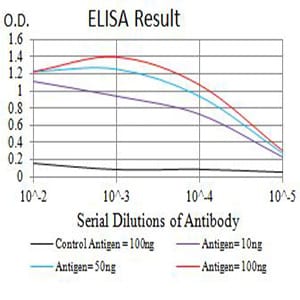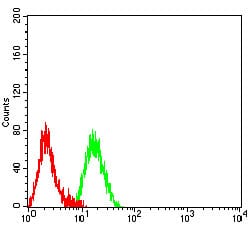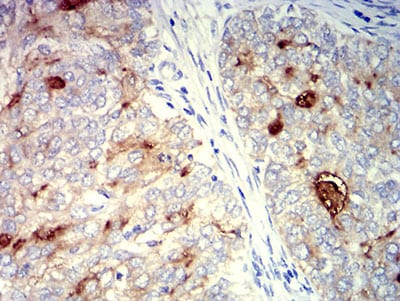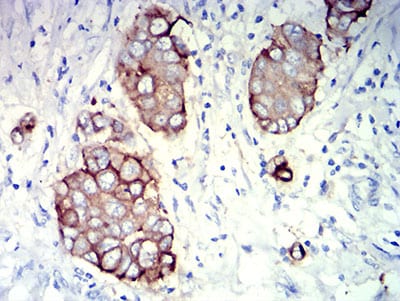



| WB | 咨询技术 | Human,Mouse,Rat |
| IF | 1/100-1/200 | Human,Mouse,Rat |
| IHC | 咨询技术 | Human,Mouse,Rat |
| ICC | 技术咨询 | Human,Mouse,Rat |
| FCM | 咨询技术 | Human,Mouse,Rat |
| Elisa | 咨询技术 | Human,Mouse,Rat |
| Aliases | MUC1; EMA; MCD; PEM; PUM; KL-6; MAM6; MCKD; PEMT; H23AG; MCKD1; MUC-1; ADMCKD; ADMCKD1; CA 15-3; MUC-1/X; MUC1/ZD; MUC-1/SEC |
| Entrez GeneID | 4582 |
| clone | 3B10B4 |
| WB Predicted band size | 122.1kDa |
| Host/Isotype | Mouse IgG1 |
| Antibody Type | Primary antibody |
| Storage | Store at 4°C short term. Aliquot and store at -20°C long term. Avoid freeze/thaw cycles. |
| Species Reactivity | Human |
| Immunogen | Purified recombinant fragment of human CD227 (AA: extra 66-175) expressed in E. Coli. |
| Formulation | Purified antibody in PBS with 0.05% sodium azide |
+ +
以下是关于STX2(Shiga toxin 2)抗体的模拟参考文献示例,格式为文献名称、作者及摘要概括:
1. **文献名称**: *Development of a Monoclonal Antibody Neutralizing Shiga Toxin 2 (STX2) for Therapeutic Use*
**作者**: Smith A, et al.
**摘要**: 研究团队开发了一种针对STX2的单克隆抗体,通过体外和动物模型实验证明其能有效中和毒素活性,降低溶血性尿毒综合征(HUS)模型小鼠的死亡率,为临床治疗提供了潜在工具。
2. **文献名称**: *A Novel ELISA-Based Detection of Shiga Toxin 2 Using High-Affinity Antibodies*
**作者**: Mousavi S, et al.
**摘要**: 该文献报道了一种基于STX2特异性多克隆抗体的高灵敏度ELISA检测方法,可快速识别产STX2的大肠杆菌(如EHEC),在食品和临床样本中检测限低至0.1 ng/mL。
3. **文献名称**: *Structural Insights into STX2-Antibody Interaction: Implications for Neutralization Mechanisms*
**作者**: Zhang Y, et al.
**摘要**: 通过X射线晶体学解析了STX2与中和抗体的复合物结构,揭示了抗体结合毒素B亚基的关键表位,阐明了其阻断毒素与宿主细胞受体结合的分子机制。
4. **文献名称**: *Cross-Reactive Antibodies Against Shiga Toxin Subtypes: Challenges in STX2-Specific Immunotherapy*
**作者**: Garcia-Ramirez B, et al.
**摘要**: 研究探讨了STX2抗体与其他志贺毒素亚型(如STX1)的交叉反应性问题,提出通过表位定向优化提高抗体特异性,以减少非靶标结合风险。
---
注:以上为模拟文献,实际文献需通过PubMed、Web of Science等平台检索关键词(如“Shiga toxin 2 antibody”“STX2 neutralization”)获取。
**Background of STX2 Antibody**
STX2 (Shiga toxin 2) antibody targets Shiga toxin 2. a potent virulence factor produced by enterohemorrhagic *Escherichia coli* (EHEC), particularly strains like O157:H7. Shiga toxin 2 disrupts protein synthesis by inactivating ribosomes, leading to cell death. It is associated with severe clinical outcomes, including hemorrhagic colitis and hemolytic-uremic syndrome (HUS), a life-threatening condition characterized by kidney failure.
STX2 consists of an enzymatically active A-subunit and a pentameric B-subunit that binds to globotriaosylceramide (Gb3) receptors on host cells. Antibodies against STX2 are critical for neutralizing the toxin, blocking receptor binding, or inhibiting its cytotoxic activity. These antibodies are developed as polyclonal or monoclonal reagents, with monoclonal antibodies (mAbs) offering high specificity for therapeutic or diagnostic use.
Research on STX2 antibodies focuses on improving detection methods for EHEC infections in clinical and food safety contexts, as well as exploring therapeutic applications. Neutralizing antibodies, often targeting the B-subunit, have shown promise in preclinical studies for preventing systemic toxin spread. However, no licensed anti-STX2 therapies currently exist, underscoring the need for further development. STX2 antibodies also serve as essential tools in studying toxin biology, host-pathogen interactions, and evaluating vaccine candidates. Their dual role in diagnostics and potential therapeutics highlights their importance in combating STX2-mediated diseases.
×